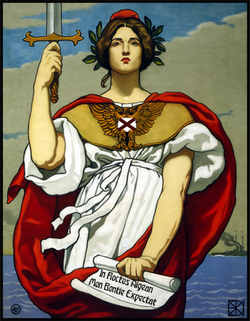Ganty and Company: Difference between revisions
Tags: Mobile edit Mobile web edit Advanced mobile edit |
Tag: 2017 source edit |
||
| Line 67: | Line 67: | ||
The narrative arc and thematic elements were crafted with a pragmatic approach, eschewing idealism in favor of grounded storytelling. The episodic structure, with each episode lasting precisely 10 minutes, was designed to cater to the attention span of young viewers while delivering substantive content. | The narrative arc and thematic elements were crafted with a pragmatic approach, eschewing idealism in favor of grounded storytelling. The episodic structure, with each episode lasting precisely 10 minutes, was designed to cater to the attention span of young viewers while delivering substantive content. | ||
== | ==Main characters== | ||
{| class="wikitable mw-collapsible" | {| class="wikitable mw-collapsible" | ||
|+Characters | |+Characters | ||
Revision as of 22:43, 21 November 2023
| Ganty and Company | |
|---|---|
 Gantry and Company | |
| Genre | Children's television series |
| Created by | Rev. Rachet-Michel Olan d'Ouestvil |
| Country of origin | |
| Original language | Burgoignesc |
| No. of series | 7 |
| No. of episodes | 98 |
Ganty and Company," a Burgoignesc children's television series which unfolds in the fictional, vibrant, and industrious port city of Orville. The narrative centers around Ganty, an anthropomorphized gantry crane, and his assorted companions, which include sentient shipping containers, trucks, and ships. Across its seven seasons, the show meticulously explores the intricacies of container port operations, infusing educational content with an entertaining narrative.
Each episode, is a concise 10-minutes long, ensuring an engaging yet digestible viewing experience for its young audience. The storytelling revolves around the collaborative efforts of Ganty and his companions, emphasizing the importance of teamwork, logistical efficiency, and problem-solving in the context of port logistics. The series provides specific insights into container handling, transportation processes, and maritime activities, fostering a nuanced understanding of these concepts among its viewers.
Notably, the writers of "Ganty and Company" steer clear of idealistic portrayals, opting instead for a realistic depiction of the challenges faced in the bustling port environment. The show maintains a balance between educational content and entertainment, presenting technical aspects in a manner that is accessible and engaging for its target audience, 5-12yr olds. As viewers follow the adventures of Ganty and his friends, they gain a practical understanding of the intricate world of container shipping, making "Ganty and Company" a valuable and informative addition to children's programming.
History
| This article is part of a series on the |
| Culture in Burgundie |
|---|
 |
| Society |
| Arts and literature |
| Other |
|
Burgundie portal |
Ganty and Company stems from a deliberate fusion of educational objectives and creative storytelling developed the PR firm working for the Burgoignesc South Levantine Trading Company and the Ministries of Trade and Education of the Government of Equatorial Ostiecia. The conceptualization of the series emerged through collaborative efforts between content creators, educators, and industry experts, all aiming to bridge the gap between entertainment and informative programming for young minds.
The government of Equatorial Ostiecia funded the project with a $200,000 grant that allowed the assembled to meticulous research into the operational dynamics of container ports, drawing inspiration from real-world logistics and maritime activities. Industry professionals, including engineers and logistics specialists from companies like O'Shea Operation Management Services, the Burgoignesc South Levantine Trading Company, and O’Shea Container Shipping, were consulted to ensure a nuanced and accurate portrayal of the subject matter. The decision to focus on an anthropomorphized gantry crane, Ganty, and his diverse ensemble of sentient shipping containers, trucks, and ships, was a strategic choice to personify key elements of the port environment and make the content relatable to young children.
The narrative arc and thematic elements were crafted with a pragmatic approach, eschewing idealism in favor of grounded storytelling. The episodic structure, with each episode lasting precisely 10 minutes, was designed to cater to the attention span of young viewers while delivering substantive content.
Main characters
| Portrait | Equipment type | Role/main characteristics | # of episodes | |
|---|---|---|---|---|
| Ganty the Gantry Crane | 
|
Gantry crane | Protagonist
|
98 |
| Carol the Container ship | 
|
Container ship | Protagonist's sidekick
|
92 |
| Philippe the Flatbed | 
|
Flatbed truck | Antagonist
|
96 |
| Todrick the Tug | 
|
Tugboat | Protagonist's sidekick
|
75 |
Themes
Although rooted in the perspective of its Congregationalist minister creator, the show writers adeptly weaves themes that transcend denominational boundaries, ensuring resonance with a diverse audience in the Burgoignesc Metropole and Yonderre, which are primarily Catholic, and parts of the Burgoignesc thalattocracy in Audonia they are primarily Muslim. The series subtly incorporates elements of Congregationalism and the Protestant work ethic while tactfully toning down doctrinal specifics for broader appeal.
At its core, the Protestant work ethic manifests through the characters' commitment to industriousness, responsibility, and collaborative effort within the bustling port environment of Orville. Ganty, as the central figure, embodies the virtue of diligence, symbolizing the idea that purposeful work is both fulfilling and essential. This theme is seamlessly integrated into the narrative, offering young viewers a positive perspective on the value of effort and cooperation.
The series also espouses principles of community and mutual support, aligning with Congregationalist values. Through the interactions of Ganty and his diverse group of friends, the importance of teamwork, understanding, and unity becomes a recurrent motif. The show thus promotes a sense of communal responsibility, echoing Congregational ideals in a way that transcends specific religious denominations.
Crucially, the themes are presented with a measured tone, avoiding explicit religious dogma to cater to the broader, predominantly Catholic and Muslim audience. The emphasis is on universal virtues and values that resonate across religious affiliations, fostering inclusivity and a shared understanding of positive moral principles.
In navigating this delicate balance, "Ganty and Company" successfully imparts moral lessons and work ethic values without imposing specific religious doctrines. By doing so, the series emerges as a culturally sensitive and enriching experience for its viewers across the Burgoignesc thalattocracy, where diverse religious backgrounds are respected while common ethical threads are celebrated.